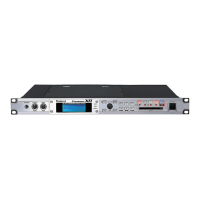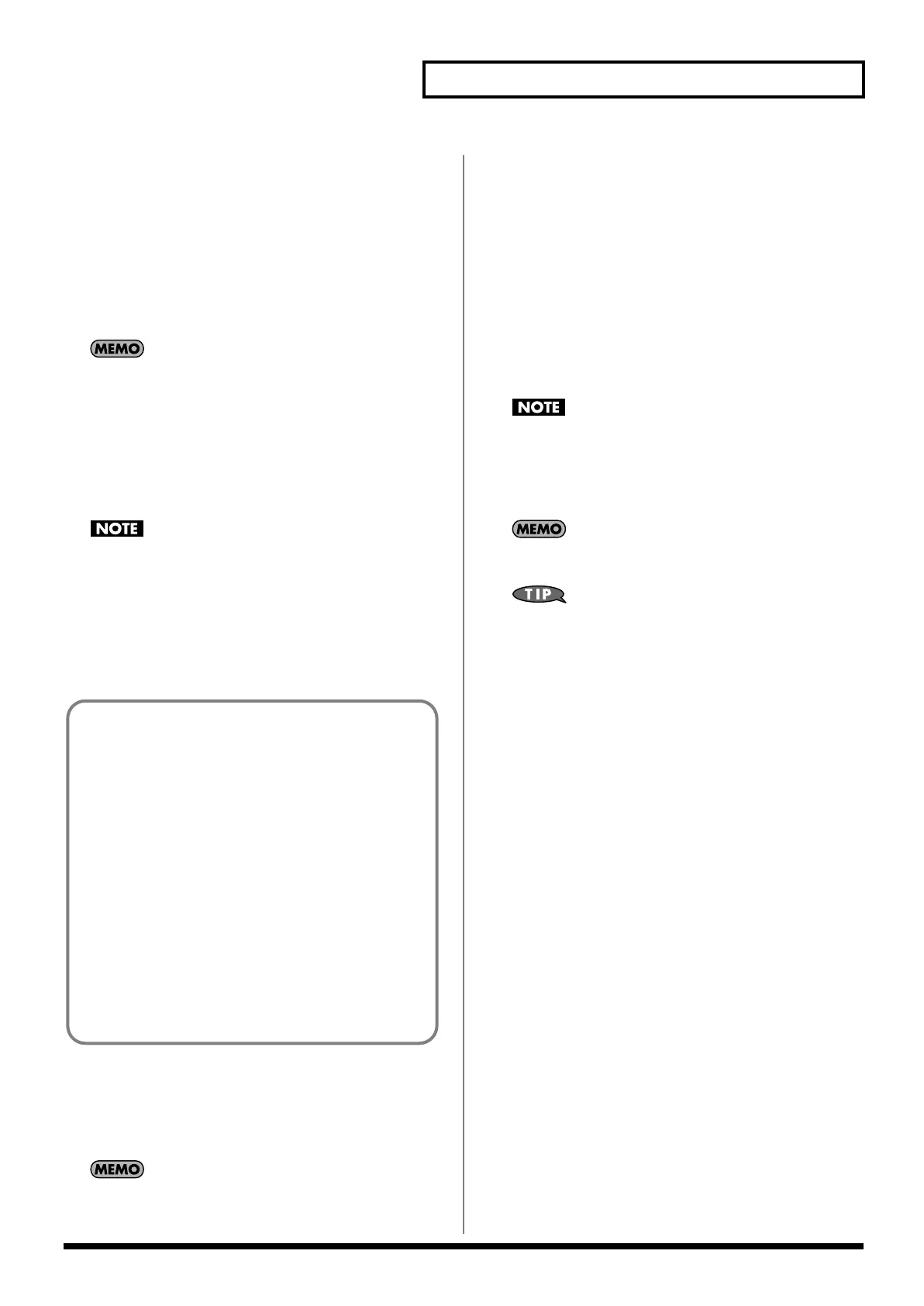89
Creating a Performance
Solo Switch
Select one part whose sound you want to play. Turn it “SOLO” to
the part that you want to solo. Parts other than the part you select
here will not sound.
Value:
–, SOLO
Mute Switch
Mutes (MUTE) or un-mutes (OFF) each part.
Value:
OFF, MUTE
The Mute Switch parameter does not turn the part off, but sets
the volume to minimum so that no sound is heard. Therefore,
MIDI messages are still received.
Octave Shift
Adjusts the pitch of the part’s sound up or down in units of an
octave (+/-3 octaves).
Value:
-3– +3
Note that when a rhythm set is assigned to a part, you cannot
modify the Octave Shift parameter.
Coarse Tune
Adjusts the pitch of the part’s sound up or down in semitone steps
(+/-4 octaves).
Value:
-48– +48
Fine Tune
Adjusts the pitch of the part’s sound up or down in 1-cent steps (+/-
50 cents).
Value:
-50– +50
One cent is 1/100th of a semitone.
Output Assign
Specifies for each part how the direct sound will be output.
Value
MFX:
Output in stereo through multi-effects. You can also
apply chorus or reverb to the sound that passes through
multi-effects.
A, B:
Output to the OUTPUT A (MIX) jack or OUTPUT B jack
in stereo without passing through multi-effects.
1–4:
Output to the INDIVIDUAL 1–4 jacks in mono without
passing through multi-effects.
PAT:
The part’s output destination is determined by the
settings of the patch or rhythm set assigned to the part.
If you’ve made settings so that sounds are separately routed to
the INDIVIDUAL 1 jack and INDIVIDUAL 2 jack, but no plug
is actually inserted in the INDIVIDUAL 2 jack, the sounds
routed to INDIVIDUAL 1 and INDIVIDUAL 2 will be mixed
and output from the INDIVIDUAL 1 jack.
If the Mix/Parallel parameter is set to “MIX,” all sounds are
output from the OUTPUT A (MIX) jacks in stereo (p. 158).
If you’ve set Tone Out Assign to “MFX,” set the MFX Output
Assign parameter to specify the output destination of the sound
that has passed through the multi-effects.
• Chorus and reverb are output in mono at all times.
• The output destination of the signal after passing through the
chorus is set with the Chorus Output Select and the Chorus
Output Assign.
• The output destination of the signal after passing through the
reverb is set with the reverb Output Assign.
Output MFX Select
(Part Output Multi-Effects Select)
Of the three types of multi-effects that can be used simultaneously,
specify which multi-effects will be used.
Value:
1–3 (MFX-1–MFX-3)
Output Level (Part Output Level)
Set the level of the signal that is sent to the output destination
specified by Part Output Assign.
Value:
0–127
Chorus Send Level (Part Chorus Send Level)
Sets the level of the signal sent to chorus for each part.
Value:
0–127
Reverb Send Level (Part Reverb Send Level)
Sets the level of the signal sent to reverb for each part.
Value:
0–127
Coarse Tune and Octave Shift
The Coarse Tune and Fine Tune parameters, along with the
Octave Shift parameter, can all be seen as doing the same thing
to the sound, i.e., changing the pitch of the sound. For example,
if C4 (Middle C) is played with the Coarse Tune parameter set
to “+12,” the note produced is C5 (one octave above C4). For
example, if C4 (Middle C) is played with the Octave Shift
parameter set to “+1,” the note produced is C5 (one octave
above C4).
However, internally these function very differently. When the
Coarse Tune parameter is set to “+12,” the pitch itself is raised
one octave. On the other hand, when the Octave Shift parameter
is set to “+1,” it is the same as pressing the keys one octave up.
In other words, use the Coarse Tune parameter when changing
the pitch, and the Octave Shift parameter when you want to
shift the entire keyboard, for example, when the number of keys
is insufficient.
Fantom-XR_r_e.book 89 ページ 2006年4月4日 火曜日 午前10時14分

